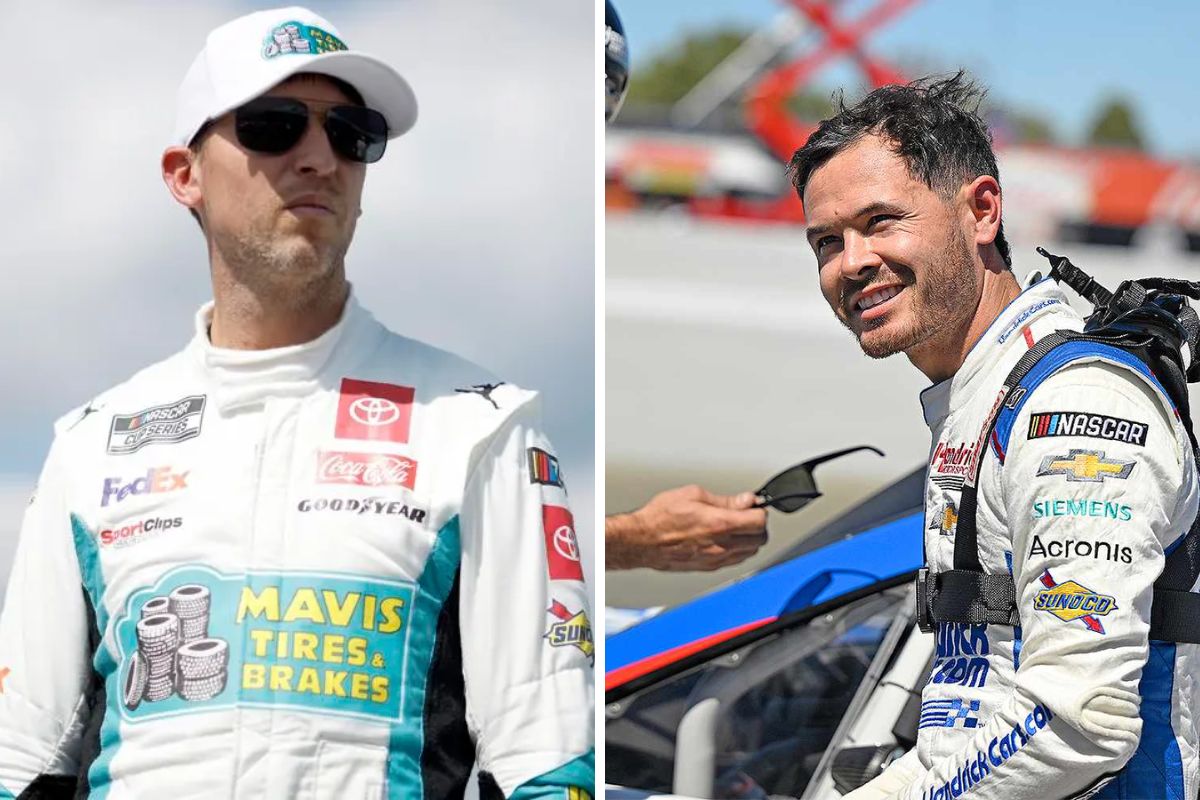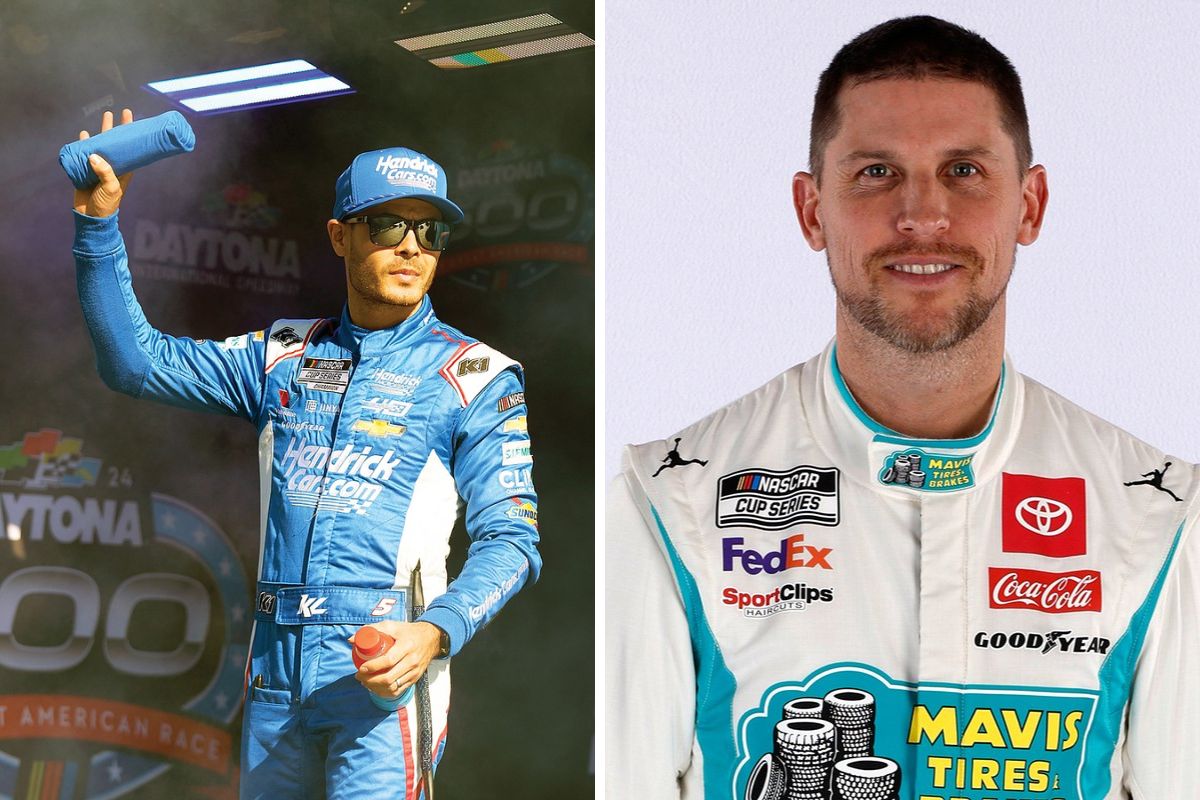Denny Hamlin Responds to Larson: In the wake of the Dover race, the debate between Denny Hamlin and Kyle Larson over the role of in-car cameras in NASCAR’s aero blocking issue brings to light the complexities of modern motorsport competition. Hamlin’s insistence on a holistic review of race regulations and car designs rather than Larson’s narrower focus on in-car technology highlights a broader dialogue about the evolution of racing strategy and vehicle dynamics. This debate not only reflects individual perspectives but also influences potential regulatory adjustments that could reshape the landscape of NASCAR.
Key Takeaways
- Hamlin disagrees with Larson’s suggestion to remove in-car cameras, advocating for broader changes.
- Emphasizes the need for a holistic approach to address aero blocking issues.
- Highlights the importance of driver skill and strategic decision-making in overcoming racing challenges.
- Disputes Larson’s focus on specific technological aspects, suggesting more comprehensive car design and race rule modifications.
- Stresses that both driver feedback and technological innovation are critical for evolving NASCAR’s competitiveness and safety.
Larson and Busch Blame Aero Blocking for Dover Loss
Following their disappointing performance at the Wurth 400 Race in Dover, both Kyle Larson and Kyle Busch cited the next-gen cars’ aero blocking as a major factor hindering their ability to navigate effectively on the track. This issue brought a spotlight onto the aerodynamic challenges posed by the newer generation of NASCAR vehicles. Importantly, both drivers, with proven track records and high expectations, found themselves grappling with the reality of reduced agility, which greatly deviates from their experiences in older car models.
The next-gen cars, designed for improved safety and competitiveness, incorporate advanced aerodynamics that, while theoretically promoting closer and more exciting racing, also introduce intricate dynamics such as increased aero dependency and sensitivity. This sensitivity, in turn, leads to aero blocking—an unintended consequence where the airflow managed by leading cars adversely affects the trailing cars’ ability to maintain speed and handling stability in close quarters.

Larson’s Proposal and Hamlin’s Response
In the wake of Larson’s suggestion to remove in-car cameras as a means to mitigate aero blocking, Denny Hamlin provided a contrasting perspective, emphasizing the minimal impact of such cameras on the dynamics of racing. Hamlin, fresh from his victory at Dover, articulated a detailed view that frames the in-car camera not as a crucial tool in aero blocking, but rather as a minor element within the broader strategic gamut of racing. He posited that the core challenge of aero blocking transcends the mere availability of visual aids, suggesting instead that it’s deeply rooted in the aerodynamic design of the cars and the race strategies employed by drivers.
“It’s really hard to pass the lead car. […] Honestly, if they took the cameras out of the car, that’s probably one of the little things that could fix it. It’s hard to see out of the rearview mirrors, but the cameras are so easy. I would be for it if they took the cameras out. I don’t know if he ;[Hamlin] runs the camera, he probably does and it’s really easy.”larson
Hamlin’s response illuminates a broader discourse on technological integration in sports—where the line is drawn between enhancing viewer experience and maintaining the sport’s integrity. By downplaying the impact of in-car cameras, Hamlin implicitly emphasizes the significance of driver skill and strategic expertise over technological assistance. This perspective invites a reevaluation of how technology should be wielded in racing, advocating for a balance that respects both competitive fairness and the spectator’s engagement.
“Yeah, I mean, I use it at times. I didn’t use it much today simply because Dover is just a track where things happen so fast. I feel like personally if I take my eyes off the road for a second, I take it to the camera, I’ll miss my line kind of rely more on the spotter to defend than I do the actual camera just simply because I don’t think I’m good enough to drive and look backwards.”-Hamlin
Hamlin and Larson Clash
Despite Larson’s proposal to remove rear-view cameras from racecars, Hamlin expressed strong reservations, highlighting that such a measure would unlikely resolve the underlying complexities of aero blocking. Hamlin, a seasoned driver with detailed understanding of race dynamics, argued that the real issue lies deeper within the aerodynamics and mechanical setups of the cars. According to him, simply removing a technological aid like a rear-view camera doesn’t address the root cause but rather sidesteps the broader technical challenges that modern racing confronts.
In contrast, Larson’s view was that the removal of these cameras could lead to a more natural racing environment, potentially reducing the strategic but often criticized practice of aero blocking. This difference in perspectives not only demonstrates their divergent approaches to racing technology but also highlights a gap in strategic philosophies between two top competitors.
| Aspect | Impact on Emotion |
|---|---|
| Safety Concerns | Raises anxiety about potential increased risks. |
| Racing Integrity | Sparks debate on the purity of the sport. |
| Driver Skill | Emphasizes reliance on raw talent over tech. |
| Fan Experience | Concerns over less predictable race outcomes. |
.@dennyhamlin disagrees with @KyleLarsonRacin about removing review in-car cameras on the Next Gen.
Hamlin says he barely looked at his today and that the spotter does the same thing, so we should focus on bigger car issues than removing the camera. #NASCAR pic.twitter.com/aO2NPWmGJT
— Noah Lewis (@Noah_Lewis1) April 28, 2024

Hamlin Matches Lee Petty’s Record
Denny Hamlin’s recent victory at Dover not only marked his third win of the season but also positioned him alongside racing icon Lee Petty in the annals of NASCAR history with 54 career victories. This alignment with Petty, a pioneer of stock car racing and a three-time Grand National (now NASCAR Cup Series) champion, highlights Hamlin’s consistent performance and impact in the sport.
Achieving this milestone, Hamlin demonstrated a blend of strategic intelligence and driving skill, traits that were characteristic of Petty during his prime. Petty, who raced in the formative years of NASCAR, set benchmarks that have challenged drivers for decades.
Hamlin’s Strong Season and Playoff Prospects
Hamlin’s trio of victories this season highlights his formidable presence in NASCAR, yet historical trends suggest a need for strategic adjustments to avert his usual playoff fade. Hamlin’s current season trajectory is impressive, marked by strategic driving and opportunistic strategies that have positioned him as a top contender. However, his pattern of diminishing returns in the playoff stages necessitates a critical assessment of his approach during these decisive races.
“It’s just fantastic; I mean, I couldn’t hold Lee Petty’s helmet, but I’ve been blessed with a great race team. This whole FedEx team, Sports Clips, and everyone that supports this 11-car. They are the ones that make it happen. I’m the lucky one who gets to drive it.”-Hamlin
The core of Hamlin’s challenge lies in maintaining peak performance under the heightened pressures and variable conditions of the playoffs. Traditionally, his early-season vigor has not seamlessly translated into end-season accomplishments, often due to strategic missteps or unforeseen complications.
Moreover, Hamlin’s team, Joe Gibbs Racing, plays a significant role in this equation. Collaborative efforts to engineer a car that maintains its competitive edge throughout the season and adapts quickly to the diverse tracks and weather conditions encountered in the playoffs are crucial.

News in Brief: Denny Hamlin Responds to Larson
The debate surrounding aero blocking within NASCAR, exemplified by the differing views of Kyle Larson and Denny Hamlin, highlights the complexity of motorsport regulations and their implications for competition integrity.
Hamlin advocates for a comprehensive revision of car designs and racing rules, suggesting that addressing the root causes is preferable to implementing superficial measures. This approach not only enriches the sport’s competitive nature but also prioritizes safety and improves the overall spectator experience.
Our Reader’s Queries
Q: Who does Denny Hamlin own?
A: Denny Hamlin pilots the No. 11 Toyota for Joe Gibbs Racing and co-owns 23XI Racing with NBA icon Michael Jordan in the NASCAR Cup Series. With an impressive tally of 53 wins, his victories include prestigious events like the Coca-Cola 600 (2022), Daytona 500 (2016, 2019, 2020), and Southern 500 (2010, 2017, 2021).
Also Read: Denny Hamlin’s Victory at Dover, Claims Third Win of the Season

